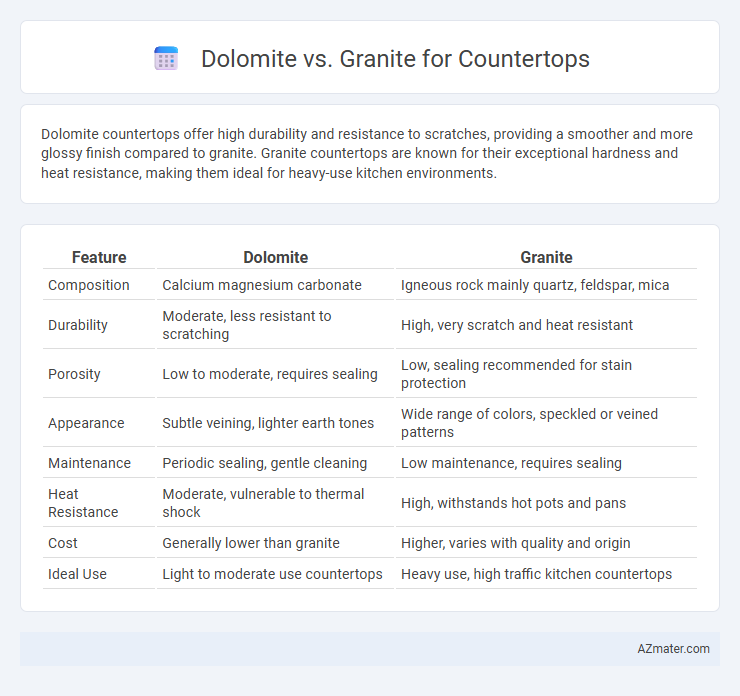Dolomite countertops offer high durability and resistance to scratches, providing a smoother and more glossy finish compared to granite. Granite countertops are known for their exceptional hardness and heat resistance, making them ideal for heavy-use kitchen environments.
Table of Comparison
| Feature | Dolomite | Granite |
|---|---|---|
| Composition | Calcium magnesium carbonate | Igneous rock mainly quartz, feldspar, mica |
| Durability | Moderate, less resistant to scratching | High, very scratch and heat resistant |
| Porosity | Low to moderate, requires sealing | Low, sealing recommended for stain protection |
| Appearance | Subtle veining, lighter earth tones | Wide range of colors, speckled or veined patterns |
| Maintenance | Periodic sealing, gentle cleaning | Low maintenance, requires sealing |
| Heat Resistance | Moderate, vulnerable to thermal shock | High, withstands hot pots and pans |
| Cost | Generally lower than granite | Higher, varies with quality and origin |
| Ideal Use | Light to moderate use countertops | Heavy use, high traffic kitchen countertops |
Introduction to Dolomite and Granite Countertops
Dolomite countertops, composed primarily of calcium magnesium carbonate, offer a durable and naturally elegant surface with resistance to scratches and heat, making them suitable for modern kitchens. Granite countertops, formed from cooled volcanic magma, provide exceptional hardness, unique grain patterns, and high durability, favored for their aesthetic appeal and longevity. Both materials require proper sealing to maintain their stain resistance and preserve their natural beauty in busy kitchen environments.
Composition and Appearance Comparison
Dolomite countertops are composed primarily of calcium magnesium carbonate, offering a slightly softer, more porous surface compared to granite's dense, interlocking crystal structure of quartz, feldspar, and mica. Granite features a more varied color palette, including speckled patterns with flecks of black, white, pink, or green, while dolomite tends to have a softer, more uniform light cream or white appearance with occasional veins. Both materials provide durability for kitchen countertops, but granite typically resists staining and scratching better due to its harder mineral composition.
Durability and Hardness
Dolomite countertops offer high durability and hardness, often rated around 5.5 to 6.5 on the Mohs scale, making them resistant to scratches and wear. Granite, with a higher Mohs hardness of about 6 to 7, is generally tougher and more scratch-resistant, suitable for heavy-use kitchen surfaces. Both materials provide excellent durability, but granite tends to outperform dolomite in hardness and long-term resilience.
Stain and Scratch Resistance
Dolomite countertops offer moderate stain resistance but are more prone to etching from acidic substances compared to granite. Granite exhibits superior scratch resistance due to its hardness, making it more durable in high-traffic kitchen environments. Both materials require sealing, but granite generally provides better overall protection against stains and scratches.
Maintenance and Cleaning Requirements
Dolomite countertops require gentle, pH-balanced cleaners to prevent etching and must be sealed regularly to protect against stains and moisture damage. Granite surfaces are more durable and less porous, making them easier to maintain with mild soap and water, but periodic sealing is still recommended to maintain resistance to stains and bacteria. Both materials benefit from avoiding harsh chemicals and abrasive cleaning tools to preserve their polished finishes and longevity.
Heat Resistance Capabilities
Dolomite countertops offer high heat resistance, typically withstanding temperatures up to 1,000degF without damage, making them suitable for kitchens where hot pots and pans are frequently placed on surfaces. Granite also provides excellent heat resistance, handling temperatures around 1,200degF, which makes it slightly more durable against thermal shock compared to dolomite. Both materials are natural stones prized for their durability, but granite's higher heat tolerance often makes it the preferred choice for heat-prone kitchen environments.
Cost Differences
Dolomite countertops generally cost less than granite, with prices ranging from $45 to $75 per square foot compared to granite's $50 to $100 per square foot. The lower cost of dolomite is due to its abundance and easier quarrying process, while granite's price reflects its durability and unique patterns. Choosing between dolomite and granite depends on budget considerations balanced against aesthetic preferences and long-term value in kitchen design.
Installation Considerations
Dolomite countertops require professional installation due to their density and brittleness, which necessitates precise cutting and handling to avoid cracks. Granite, while also heavy and durable, is slightly more forgiving during installation but still demands skilled labor and proper support to prevent damage. Both materials require specialized tools and expertise, but granite's widespread use often means easier access to experienced installers and varied installation options.
Pros and Cons of Dolomite vs Granite
Dolomite countertops offer remarkable hardness and resistance to scratches and heat, making them a durable choice for kitchens, while their light, natural veining adds elegant appeal. Granite provides exceptional strength and a wide range of colors and patterns, with superior resistance to stains and heat, but it requires periodic sealing to maintain its protective barrier. Dolomite is less porous than granite, reducing the risk of bacteria absorption, yet it may be more prone to etching from acidic substances compared to granite's more robust surface.
Which Countertop Material is Best For You?
Dolomite countertops offer a natural, elegant appearance with excellent durability and resistance to scratches and heat, making them ideal for busy kitchens. Granite provides superior hardness and variety in colors and patterns, which suits homeowners seeking a unique, long-lasting surface for high-traffic areas. Choosing between dolomite and granite depends on your preference for aesthetics, maintenance requirements, and budget considerations.

Infographic: Dolomite vs Granite for Countertop
 azmater.com
azmater.com